The goal of restoration activities in Kantishna is to restore damaged streams to some semblance of healthy stream function, including improved water quality, riparian habitat (vegetation), and aquatic life.
Introduction
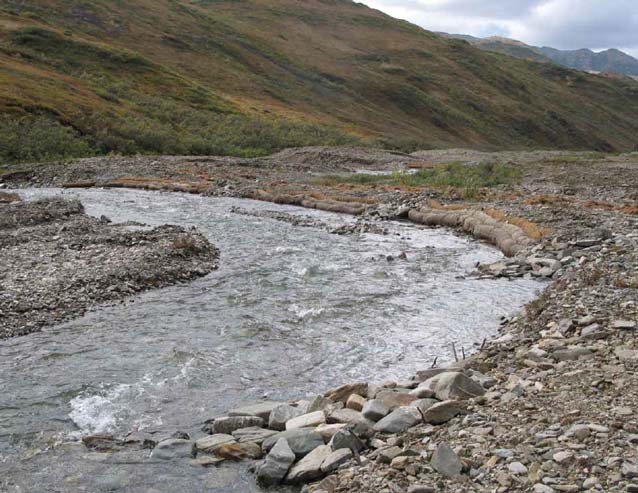
NPS Photo
The Kantishna district of Denali National Park and Preserve (Denali) has a history of mining dating to an early stampede of fortune seekers (c. 1905). The initial rush subsided quickly, but mining continued there through 1985. Miners sought ore in many different ways, including manual placer mining, excavation of hard rock mines, and use of heavy equipment to scour stream beds. Some miners restored their claims and removed their camps upon completion of mining, while others did not.
At the time, the mining claims in the Kantishna Hills were outside the boundaries of the park. When the park tripled in size in 1980, Kantishna’s mining claims became included in Denali, making the claims subject to the Mining in the Parks Act of 1976.
Some claims later acquired by the NPS included abandoned hazardous materials, abandoned camp infrastructure and mining equipment, non-functional floodplains, tailing piles, and exposure of streams to heavy metals. Reclamation efforts were necessary to mitigate the impacts of mining on the stream ecosystems in the park.
The goal of restoration activities in Kantishna is to restore damaged streams to some semblance of healthy stream function, including improved water quality, riparian habitat (vegetation), and aquatic life.
Reclamation activities in Kantishna began in 1989 and have continued sporadically until 2008, including substantial activities on lower Glen Creek, Red Top Mine, Eureka Creek, and Moose Creek. To address the remaining large-scale restoration need in Kantishna, the park received NPS funds for work in 2008-2010.
Primary efforts focused on Glen Creek (2009), Caribou Creek (2010), and Slate Creek (2010). Slate Creek and Caribou Creek were classified as impaired waterways under the Clean Water Act at the beginning of this effort based on their high turbidity and compromised water quality.
Restoration activities included removing hazardous materials, contaminated soils, and abandoned equipment; reconstructing floodplain and stream channel structure; stabilizing stream banks from erosion; and revegetating the site. Success is measured through stream channel and floodplain character, water quality, and re-vegetation success.
Design Considerations
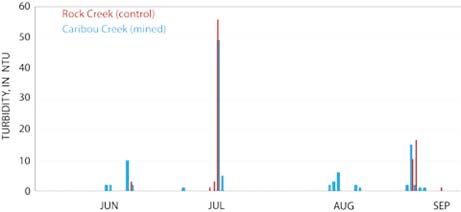
The design guidance for these projects was based on a long-term stream restoration and monitoring project, initiated in lower Glen Creek in 1991.
The objective of that project was to test channel/floodplain design methods for riparian habitat recovery, and to conduct research and monitoring for future projects in Kantishna. The goal for the original design was to develop a stable channel and floodplain system
in coarse alluvium (Karle and Densmore 1994).
Design flood flows were estimated from regional multiple-regression techniques, and slope and sinuosity determinations were made by regional comparisons to other Kantishna streams. Shear stress equations
were applied to determine both bed and bank stability. Floodplain design was based on a 100-year flood capacity.
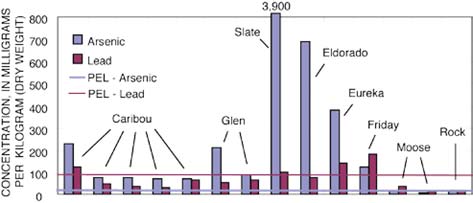
Though some of the early techniques continue to be used, lessons learned in the past 20 years have resulted in significant changes. For example, slower-than-expected revegetation rates have altered our approach.
On banks and floodplains, vegetation is an essential component of structure and stability. The root system anchors the sub-strate, and above-ground stems decrease water velocity, catch organic debris, and promote sediment deposition. Revegetation growth was even slower than expected, due to the lack of soil and low nutrient levels in the mine tailings. The new design guidelines place less emphasis on desired channel geometry and greater emphasis on addressing excess sediment supply in the watershed.
The importance of determining all causes for the disequilibrium of an unstable system requires an accurate assessment of the sediment regime for the entire watershed. In many disturbed watersheds, impacts such as road construction and vegetation alteration can lead to accelerated bank erosion and mass wasting, resulting in abnormally high rates of sediment loading, bar deposition, and increased width/depth ratios. In many of the mined Kantishna watersheds, the upstream sediment supplies from tailing piles, incised channel conditions, and denuded floodplains are essentially limitless.
Given the slow revegetation rates and the flashy watershed, mor-phological changes will likely occur for years following channel reconstruction, unless actions are taken to reduce upstream sediment loading (Densmore and Karle 2009).
Another design consideration is related to extent of erosion and deposition occurring in the watershed during years without large floods. We used a 20-year return period for our original design flood; however, channel monitoring showed substantial changes from smaller annual flows.
This indicates that the effective discharge (which generally transports the most sediment over time) is significantly smaller in an unbalanced system with excess upstream sediment. These factors now drive the channel and floodplain designs used in Kantishna.
Construction Access
Remote locations, abandoned and rough roads, stream crossings, NPS regulations, and sensitive environments all contributed to access challenges. Road improvements and maintenance were integral components of the stream restoration.
All locations required a Road Travel Permit to drive the 92-mile Park Road to Kantishna, and rough mining trails provided access to the reclamation sites beyond Kantishna.
Earthwork and Removal of Abandoned Equipment
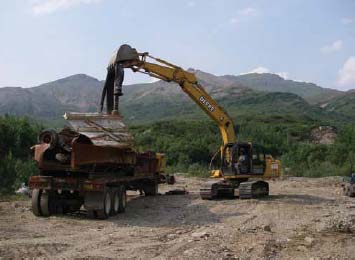
NPS Photo
Heavy equipment was used in all phases of the reclamation work, including road preparation, mining debris and equipment removal, floodplain contouring, channel construction, bank treatments, installation of in-stream controls, tailings pile earthwork, and re-vegetation. Abandoned equipment and mining debris, which ranged from screening plants to school buses, was removed from all sites.
The range and volume of debris removed required substantial planning and time, with 100-tons being removed from one site alone (Moose Creek). Items were transferred to Kantishna property owners for reuse (e.g. reusable buildings), recycled (e.g. scrap metal), staged for burning (e.g. wood debris) or landfilled.
In Caribou Creek, to reduce sediment sources during high water events, a 125-foot section of bank (which was the side slope of a remnant tailings pile) was moved away from the stream, widening the floodplain by more than 15 feet. This floodplain bench was established two feet above the adjacent thalweg and provides conveyance for higher flows in a formerly constricted portion of the stream.
Excavation of an extended tailings pile at Slate Creek was one of the significant challenges. The tailings were comprised of fine silt, clay, and gravels and were saturated from hillside seeps and precipitation. Excavation of the fine material, in a saturated condition, resulted in liquefying of the tailing pile at times.
Excavating this extended tailings pile removed a substantial volume of loose and unstable substrate from the floodplain that was contributing to accelerated erosion, sedimentation, water turbidity, and water quality degradation to Slate, Eldorado, and to some extent, Moose Creek. The new slope, where excavated material was removed, was constructed to match the existing, natural valley side slopes and was treated with biodegradable erosion blankets.
Channel Construction
A section of Caribou Creek was straightened (radius of curvature was too small), moved to the center of the valley, and shortened by 500 feet. Additionally, four rock weirs were constructed at the upper end of this reroute to direct and control flows into the new channel.
At Slate Creek, a new 400-foot channel was constructed to redirect streamflows around the main pit area of the former mine. Fabric-encapsulated soil lifts (FESLs) were used to construct the new stream banks. Additionally, willow cuttings were planted into the lifts for revegetation and long-term stability. Rock was placed in the channel to provide roughness to the steep channel (7-10% slope).
Streambank Stabilization
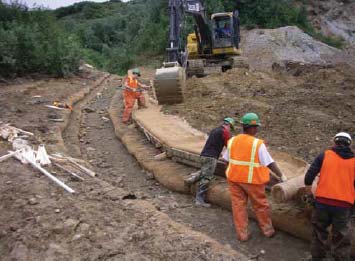
NPS Photo
At Glen Creek, the size, steepness, and location of
a particular tailings pile precluded its removal entirely from the floodplain. Instead, gabion baskets and Reno Mattresses were installed at the toe of the slope to prevent lateral erosion of the creek into the tailings pile. As was common to all sites, existing site conditions had changed in the seasons between design surveys and construction, requiring some modifications by on-site crews.
Coconut fiber coir bio-logs and rock weirs were the primary constructed streambank stabilization on Caribou Creek. Bio-logs were installed in four sections and were a mix of new logs and re-use of logs on site from previous reclamation efforts in 2002. Rock weirs were constructed to direct flows away from unvegetated banks during high flows.
Revegetation
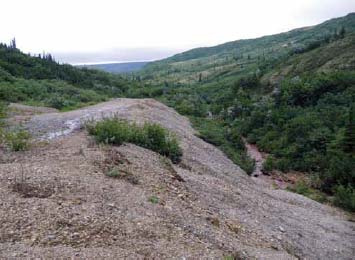
NPS Photo
Revegetation consisted of scarifying and grading tailings piles and roadbeds, tracking slopes, transplanting vegetation, installing willow cuttings and/or erosion blankets, seeding with native plants and temporary erosion control ryegrass, hydroseeding, liming, and fertilizing at prescribed rates. Nearly 4,000 willow cut-tings were installed at the Slate Creek site alone, although at most sites the number of cuttings numbered in the hundreds. The Denali Revegetation Manual (Densmore et al. 2000) was used as a guide for revegetation efforts.
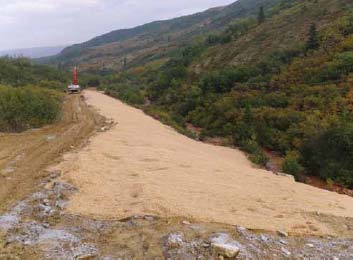
NPS Photo
Water Quality
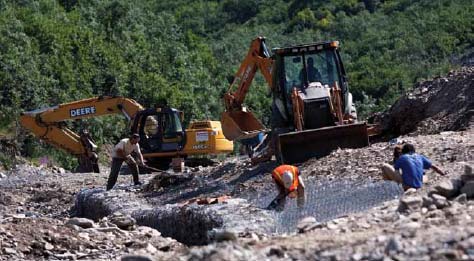
NPS Photo
Extensive water quality measurements were made at the conclusion of mining in the 1980s (Deschu 1985), but has not been consistently monitored since then. To determine the effects of reclamation on water quality and provide baseline data, water quality monitoring was re-established in 2008. Initially, 15 sites, including sites at Caribou Creek, Glen Creek, and Slate Creek, were selected for water quality monitoring in the Kantishna Hills (Figure 1).
Most of the monitoring sites are located on streams that have been mined with the exception of Rock Creek, which serves as a reference site. Data being collected include trace elements in streambed sediments; major ions, trace elements, and suspended sediment in water; field parameters (flow, water temperature, pH, specific conductance, dissolved oxygen, and turbidity); macroinvertebrates; and algae. Water temperature, specific conductance, and turbidity are continuously collected at several sites.
Water samples were collected during average flow conditions. Concentrations of suspended sediment and turbidity at all sites were low, generally less than 5 mg/L and 5 NTUs respectively. Data from previous studies in the 1980s indicated high concentrations of suspended sediment and turbidity during mining activities. The low concentrations of these constituents today indicate that the water quality has improved.
Turbidity was continuously monitored during the summer at six sites; results from Rock and Caribou Creeks, representing reference and mined sites, show nearly identical patterns (Figure 2). Periods of turbidity were due to rainfall resulting in increased streamflow. The similarity in turbidity patterns between these two sites suggests that much of the mined lands in the Caribou Creek watershed have been re-vegetated, reducing the amount of sediment entering the stream.
Streambed sediments were sampled for 34 trace elements at 14 of the sites in 2008. Metals such as arsenic and lead in streambed sediments can be harmful to aquatic life. A guideline known as the probable effect level (PEL) (MacDonald et al. 2000) above which adverse effects are expected to occur is used here for comparative purposes.
The PELs for arsenic and lead are 17.0 and 91.3 milligrams per kilogram dry weight, respectively. Arsenic concentration for Slate Creek was 3,900 mg per kilogram and all sites with mining exceeded the PEL limit for arsenic (Figure 3). The Moose Creek and Rock Creek sites were slightly over the PEL limit. Some of the mined sites also exceeded the PEL for lead.
Benthic macroinvertebrates were sampled at seven sites in 2008 and 2009. The USGS National Invertebrate Community Ranking Index incorporates 11 metrics to rank sites with regard to land use (undeveloped, mining, urban, etc.).
Slate Creek and Friday Creek scored lowest on the NICRI, whereas the downstream-most Caribou Creek site and Rock Creek scored highest, suggesting Caribou Creek appears to be recovering from prior mining activity.
Conclusion
Since 1985, when most mining ceased in Kantishna Hills, water quality conditions at most streams have improved. Restoration efforts as well as natural re-vegetation have resulted in decreased suspended sediment and turbidity levels in all streams.
Trace element concentrations in streambed sediments from a number of small watersheds indicate that arsenic concentrations could adversely affect aquatic life. A major accomplishment of restoration has been the delisting of Caribou Creek from the Clean Water Act section 303(d) list in 2010. Slate Creek is still a degraded watershed, but new efforts in 2010 to repair previous mining damage by adding structure and complexity to the system offer a promising future for the watershed. Continued water quality monitoring will determine if these efforts have improved water quality.
These reclamation activities, along with numerous other efforts since 1989, have removed thousands of pounds of abandoned equipment from national parklands, improved riparian function and stream dynamics, and have improved aquatic habitat and water quality.
The collective effort of the engineers, scientists, field crews and support staff have resulted in a measurable improvement in the condition
of natural resources in the Kantishna Hills.
Part of a series of articles titled Alaska Park Science - Volume 10 Issue 2: Connections to Natural and Cultural Resource Studies in Alaska’s National Parks.
Last updated: February 5, 2015
